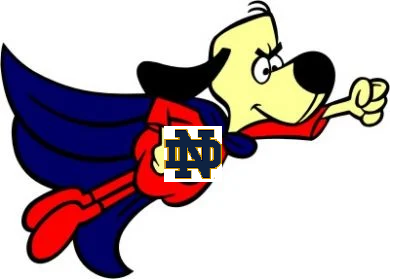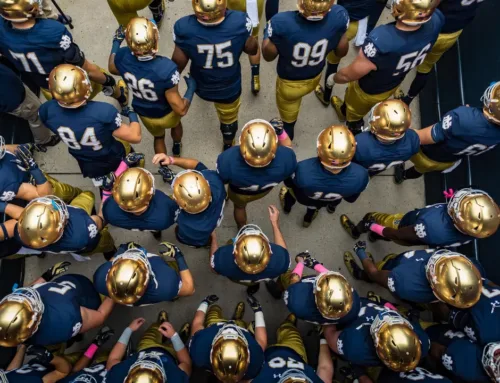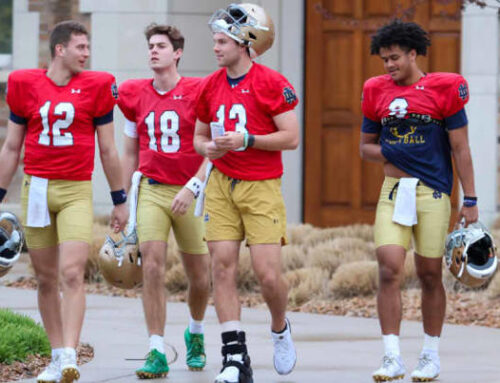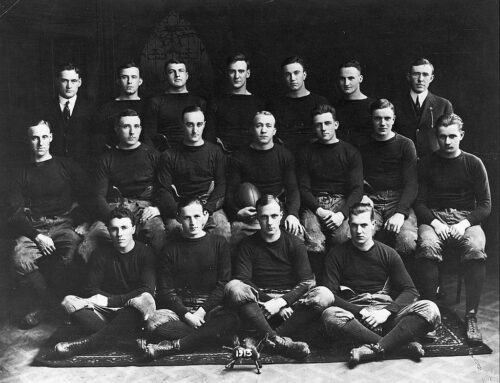When a team is hovering around a three-touchdown underdog, a lot of match-up and scheme questions go out the window in favor of simple ones – How do the Irish stay competitive with a historic Alabama offense? What would the path to an upset victory even look like? What moves give Clark Lea and Tommy Rees the best chances to win their matchups?
In an era of offensive explosion, where the single most important unit is an elite passing game, Alabama has fielded a historic attack (despite a QB with little hype entering the season). The stats are all insane, but to keep it simple, they’ve been better than last year’s historic Joe Burrow attack at LSU. The Tide average 4.38 points per offensive drive (excluding garbage time), and gain 73.4% of available yards (last year the Tigers were at 4.1 points / drive and gained 69% of available yards).
To give Notre Dame the best shot, Brian Kelly needs to embrace an underdog strategy. In broad terms, this means maximizing variance – if these teams play 10 times, Nick Saban is getting a Gatorade bath at the end of 8 or 9. But over the course of a smaller sample – a game, or ideally just ten possessions – the Irish can take advantage of randomness and swings in quality of play.
The goal: maximize variance
The challenge is that maximizing variance in football is complicated. In basketball, an underdog can slow down the game, strategize into giving up certain types of shots defensively, and shoot a ton of threes to introduce all kinds of variability. Shortening the game and increasing your range of outcomes can be done in a somewhat coordinated way. Failure on a possession (a three-point miss) has limited impact on your opponent’s next possession. But in football your goals are often at odds – an aggressive passing game that gives you a better chance of scoring can create a high-possession (variance-lowering) game.
So how should the Irish try to maximize variance against Alabama:
#1: Balance possession and aggression on offense
The Irish could take some pages from the Navy book of competing as an underdog – the modern triple option is built to create long, time-consuming possessions when at a talent disadvantage. Offensively, chewing up the clock is ideal, but this doesn’t necessitate a run-dominant attack. Burning clocks must be balanced with trying to create touchdowns, which you can’t expect to do with a run-run-pass strategy and pounding Kyren Williams into the line.
Tommy Rees can leverage a mix of passes that are more ball-control oriented (screens, high percentage play-action looks, swing passes) with deep shots that are high-reward and relatively low risk. The optimal underdog strategy is about opportunism, not conservatism– when the clock is running, milk it, and if you’re risking stopping it, take shots that make it worthwhile.
For the Irish to be successful against a Bama defense that’s shown more warts in the passing game than on the ground, this requires a multi-dimensional effort. Play-action and early deep shots may soften a defense that is likely anticipating a run-heavy attack. When running, stress the defense to account for everyone. In the Clemson game, Ian Book had zero successful runs on four attempts that netted one yard. Book’s legs and the threat of receivers in the run game will be necessary to open things up for Williams and Tyree.
#2: Tempt the Alabama offense into playing your game
Playing a low possession game isn’t solely an offensive strategy. Bait Bama into playing into a short contest– do not stack the box, guard against the pass, and bend but don’t break. This doesn’t mean you are going to stop Alabama, but letting Najee Harris go for seven yards per pop while chewing clock is better than allowing Mac Harris dropbacks that easily average ten yards per attempt and introduce a greater chance for quick-strike touchdowns. Make Bama go on 10-play drives – every play counts and is another opportunity to strip the ball, draw a penalty that increases your chances of a stop, or a limiting the damage to a field goal. The most important goal is limiting explosive plays.
A great example of this strategy working effectively was this year when the Bills faced Patrick Mahomes and the Chiefs. Buffalo played their linebackers and safeties deep, and Kansas City flipped their usual run-pass ratio as a result (from 60/40 passing to 40/60). Clyde Edwards Helaire ran for 160 yards but had the same number of carries as Mahomes had pass attempts (26). Both teams had just 9 possessions, and the Chiefs only scored 26 points, giving the Bills a real shot. Unfortunately, their offense failed to take advantage, averaging just 4.1 yards per play. It’s not a pleasant experience, but that’s the blueprint.
#3: Steal possessions in any way possible
This isn’t complicated – as an underdog, every single drive must be maximized. One cheap way to steal a possession is making sure you have the ball near the end of each half, ensuring you have at least one more total possession than the Tide. Try a surprise onside kick – what’s thirty yards of field position compared to the upside of a stolen possession?
Notre Dame should be going for it on fourth downs early and often (and importantly, planning to do so in advance, enabling more options on 3rd downs). A key mistake many underdog coaches make is waiting too late to take chances. Risks not taken early in the game (say, an early 4th and 1 from their own 35) usually translate into forced risks taken later (going for it on 4th and 10 down many scores in the second half).
Underdog coaches also tend to believe too much in early success or their teams ability to execute out of a talent disadvantage, believing it will continue. Getting a first half stop or two on Bama should be viewed as a massive win but not a sign that future drives will result in anything but touchdowns. Decisions on offense should be made under the assumption that Bama will score a touchdown when they get the ball – don’t settle for field goals unless the fourth down chance is abysmal.
There is no magic formula for beating a team like Alabama. Their weaknesses are on the margins and the Irish aren’t ideally equipped to take advantage of the Tide’s penchant for giving up long pass plays to super fast receivers. Usual tenants of good strategy apply, and Notre Dame simply has no margin for error. They need to play well and win all the little areas – turnovers, penalties, field position, and converting scoring chances to touchdowns.





Great article, enjoyed it all. This resonated with me:
“Underdog coaches also tend to believe too much in early success or their teams ability to execute out of a talent disadvantage, believing it will continue.”
You saw this in Kelly and player comments post-Clemson about only getting 3 points out of the first two drives, when they easily coulda/shoulda had 10-14. And how the whole game is different if they had put more on the scoreboard early. Maybe that helps confidence, but I doubt it — Clemson was still going to wake up and Lawrence would just be winning 24-14 at half instead of 24-3, IMO.
Also, for your point #3, I assume you would suggest it wise for Notre Dame to defer to receive to start the 2nd half if possible? Kelly seems to almost always take the ball for offense if he gets the chance and score on the game’s first possession. Which has worked, putting ND up and making (usually less talented teams) play from a deficit right out the gates. Here, hopefully they switch it up, Saban/Belichick style is to defer and hit that devastating score before half + score right after half and then the game is essentially over.
…So if Saban wants the ball to start the 2nd half and is prepping for a defensive first series, all the more reason for ND to force him to have it the other way around if they get the chance. That alone isn’t going to win the game, but keeping them as off-kilter as possible in breaking tendencies is going to be necessary.
Unfortunately though, IMO Kelly’s mindset reflects a lot of the quote above about early success and continuing it.
I disagree about Kelly’s falling into that trap. “Momentum” might not really be a thing but a lead is, putting pressure on your opponent to catch up depends on scoring points. We needed those points. The size of a point deficit influences strategy; the game is definitely different when you’re down by 17 vs. down 7.
I think Clemson merited a different approach than Bama for sure – in one you had advantages from the first matchup to test and the difference between being a 10ish point underdog vs 20 is pretty substantial.
BK has never really been in a circumstance like this, but generally, it seems like he takes careful chances but falls back mostly on scheme + execution. In a game like this you need to take the long view – somehow up 7, 4th and goal from the 5? Go for it, you need the points.
I think it’s less about deferring or not as much as trying to gameplan around having the ball last at halftime to prevent that Belichick move. The double-up can be brutal, but if things go bad, it’s bad either way – how bad would it feel giving up a first-drive TD, then punting?
Fair enough. I def agree and you have a good point that it certainly is less about a pre-game strategy/decision and more about what happens when the game begins that will chart the course….What would be interesting to me would be to see if Kelly is interested in breaking tendency.
(This might be a good off-season filler/philosophical article to research, if possible, something as basic as the coin tosses. How often does ND win and want the ball first drive of first quarter? What’s the record when they do? To me that feels like ingrained his M.O as an offensive guy who wants to score early and shape the game by ideally putting his team out in front after the very first possession of the game. As mentioned earlier, I don’t think that’s necessarily bad or wrong mindset to have to try and set the tone early and play from in front, especially against the Wake’s and Duke’s and GT’s of the world.)
Does Kelly break that this week, if he gets the opportunity? It’s not going to win or lose the game, but I think it’s an interesting little wrinkle of the overall strategy if Kelly goes against his typical mindset. IMO it’s common sense and logical he will have to switch decisions on 4th down decisions and maybe onside kicks or fake punts in order to take more chances, does this fall in that realm? Or his mindset that he wants to try and set that tone? Either way could work, either way could backfire.
Great article! I am continuously amazed when seeing the various articles that show how much of an underdog ND is, especially when looking at recruiting over the years. It makes me wonder how an all-star ND team from the BK years would do against this year’s Bama team – would they still be underdogs against the Bama recruiting machine?
QB Kizer
RB K Williams, Adams
WR Fuller, Claypool, TJ Jones
TE Eifert
OL Stanley, Nelson, Z Martin, Eichenberg, McGlinchy
DL Tuitt, Nix, Tillery, Okwara
LB Teo, Smith, Wu
CB Love, Russell
S Hamilton, Gilman
lol, yea seriously even against Bama’s best teams this would be a good game where we would be a slight favorite (the secondary being a serious hindrance – outside of Hamilton are those really our best secondary players with Kelly? Everywhere else we’ve had least had 1st round picks to round out a team basically but the secondary seems seriously weak for an all-star type team).
I think you mean outside of Consensus All-American and Thorpe award finalist Julian Love, is that our best secondary?
I mean Love had a great season and was properly awarded for it but there’s a reason he was a 4th round pick. When you compare the kind of elite WR’s that Bama has (and has had the last couple of years), he’s not going to matchup well enough that you put him on an island with them (unlike the corner’s that Bama regularly produces).
So Love is a great for a normal year but for an all-decade type team that’s pretty weak that he’s the best we got.
For Notre Dame, you list 9 first round picks (with the safe assumption Wu and Hamilton are) and 6 second rounders (assuming Eichenberg adds in here).
I think most mocks have 5 first rounders for Alabama on the current team in 2021 (including Waddle, who isn’t going to play Friday) and I saw a mock with 5 second rounders in 2021 (including their center, who won’t play). Not sure about future years.
Still kinda crazy it’s even a question. I guess on total talent alone, this 2010-20 ND team should have more raw material…But Bama this year alone has a much better overall secondary, better RBs, way better WRs, better QB and probably a better DL than the Notre Dame composite team. That’s really scary, because it’s a legit ND dream team and it still probably is only treading water with 1 year of Bama.
Michael Floyd and Harrison Smith are on this team!
Also, Book >>> Kizer or nah?
Hmm. I’d have to go with Kizer who played (I think) at a higher level for longer than Book has. Kizer through some amazing deep balls and we shouldn’t forget his running ability either.
I’d take Golson’s first year and a half (i.e. through the FSU game in 2014), then Book.
it’s astounding how much talent Bama stacks up every year.
And Rudolph.
I think our defense is capable of executing a good game plan if given one. They did against North Carolina and they shutdown the run in Clemson I. I doubt we can get a decided schematic advantage on Alabama because no such scheme exists. Otherwise, I think our DBs are especially outmatched but that would be true of pretty much any team facing Alabama, and I think I can be at peace with the result on defense. It’s offense that worries me most. Let’s target Mayer early and often and if nothing is working let’s throw some jump balls to McKinley and at least give him a shot. Maybe we can get away with a push off or two.
My main concern is you can’t game plan covering DeVonta Smith from the slot when your best slot corner is Shaun Crawford. That just doesn’t add up. No one can really cover him, period.
The ND plan vs. UNC plan was brilliant, they were going to disrupt the RPO and try to stop the run. They were successful in both.
The difference is the Bama OL is exponentially better than the UNC line. ND’s defense had success because they were in Sam Howell’s face and knocked him out of his groove. They probably won’t be able to replicate that 4 man push against Bama, which gives Mac Jones the ability to pick apart the secondary with his excellent receivers.
So I mean I agree that a good game plan on defense is going to lead to good results…I just don’t see how you can really form a good plan to stop this Alabama offense given their skill and strengths all over the field.
I agree with this. Howell was rushed the whole game. Bama’s Oline is the Great Wall of China. Jones is statuesque but has a strong, accurate arm and is very well protected.
Conversely, I think Book may well be running for his life again vs Bama. Patterson being out is huge IMO.
Taking risks on 4th downs, fake punts, onside kicks (why not start the game that way?) seems sensible to me. Make it a wild game if possible. Kelly seems pretty risk averse though.
We need some serious luck with the turnovers and early.
If we could somehow get a quick TO that turns into a TD + our own normal possession which ends in points and get up 10-14 to zero, it will at least give the sense that we can compete (even if as you said it’s not really true) and be in it the rest of the way. On the other hand, a quick strike from Bama to go down quick and early will be devastating and set up a route.
Route 66 😉
We have to be incredible when we get inside their 40. We just don’t have the explosiveness to hit on quick strikes with most of our receivers, which means you either need Tyree/Williams to break a big one, or you need to be consistent as you march down into the red zone. That’s really tough against a team of this quality. Rees will need to be creative, but not so much so that he’s putting the offense in a position to give up sacks or big losses.
When we get down near the goal line, do Mayer/Tremble/McKinley have the size and ability to get themselves open against Bama defenders? Does Tommy try something radically different down there (like tossing Kyle Hamilton on offense inside the 10 yard line)?
I love Clark Lea and I love the stability he has brought to this program, but we’re facing arguably the greatest offense of the modern era. They are going to get their points; they just are. Tommy will need to put up Touchdowns on pretty much every scoring opportunity. I certainly don’t think it’s impossible, but I also think it will be a monumental task. Here’s hoping!
Beyond bored in a doctor office waiting room, here are some other proven effective underdog strategies:
-Convince the water boy’s mother that football is a virtuous game, or short of that empower the young man to become to star linebacker behind her back anyways in order to win the game. (Possible NCAA violations since he has not graduated high school or have a GED, but you only live once) (The Waterboy)
-Have entire team threaten to quit before the game in fictional show of force, if scrappy practice squad senior isn’t allowed to dress — needlessly besmirching name of a decent guy (Rudy)
—Have entire team threaten to quit at half time if asshole head coach doesn’t resign on the spot. Allow injured star player (Jarrett Patterson? Kevin Austin?) to serve as defacto coach in second half. Run trick play with comically oversized fat guy at game’s most crucial moment. (Varsity Blues).
-Smear mud on every player’s jersey number to obstruct them. This will disguises your star players, rendering Alabama’s scouting useless. (Dawson’s Creek, shoutout my high school girlfriend, no clue how I remembered this, probably still thinking Varsity Blues)
-Allow Alabama massive early advantage to which point they become completely exhausted by celebrating their success so much, rendering themselves completely spent and unable to put up any effort in the roaring comeback (Homer Simpson boxing career approach)
-Tell Ian Book to say “screw Saban” if he suffers an injury and needs to be carted off the field at the game’s climatic moment, inspiring his teammates to score the winning touchdown. (The Longest Yard)
Where does the readership of this site stand on putting $$ on Alabama, so even if it is a blowout (currently -20 Alabama), at least some money can be made?
If nothing else, it’s a good emotional hedge. If ND puts up a really good game, you probably won’t mind losing the money as much, and if they get crushed, at least you profit.
If you bet on ND to lose by more than 20, there is a 100% chance ND will only lose by 19, on a late C’Bo meaningless garbage time TD. This is just how these things go.
Excellent article. Thanks! Hits all the areas I have been thinking about. I wonder how the issue of how often and how to blitz figures in for this game? Guess we’ll see!
Couldn’t agree more on the points made here. We broke tendencies against Clemson the first time by throwing the ball down the field, I think I saw YPA was double the 1st game to the 2nd game. We need to do that again and if we throw INTs going deep, that’s fine imo. I also think we need to challenge them across the middle and down the seams. Would love to see Tyree and Williams in the backfield together and both go out on wheel routes and using a lot of pre-snap motion all game long.
On defense, I would encourage my DB’s to hold on every play. Heck tackle the guy if you so much as think he’s going to run away from you. Basically make the refs throw a flag every play. If they do, oh well you didn’t give up a touchdown in 12 second at least. If you combine this with blitzing who knows maybe you get some pressure and the refs don’t call a flag and you get a turnover or two. Yeah the viewing public will cry and say this is awful football, but who cares.
I would also onside kick every chance I get. I don’t think there’s any shame in openly going into this as an underdog and embracing that. I think that will allow the guys to play loose and without this dread that we’ve seen in big games where we get this “oh no, it’s happening again” feeling. Who cares, everyone is expecting to happen. Let ‘er rip would be my mantra to Ian Book and the entire team.